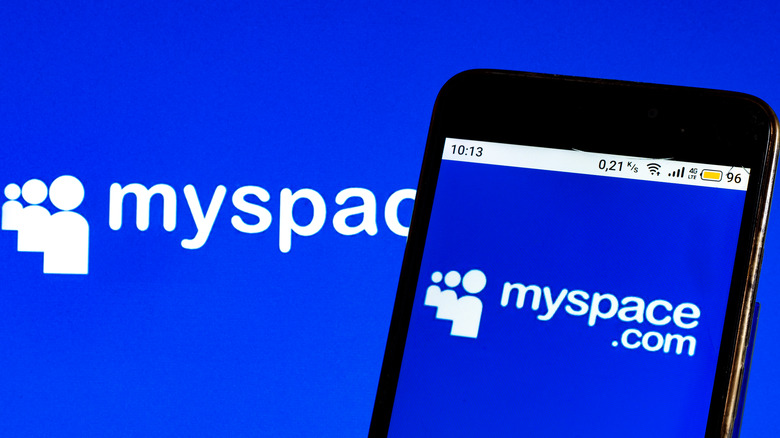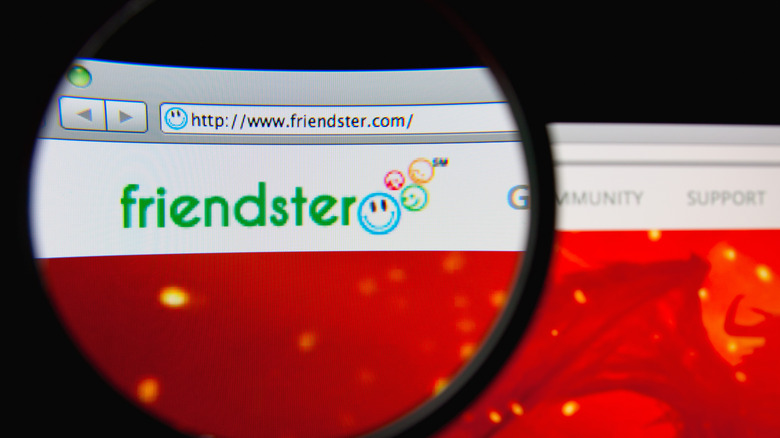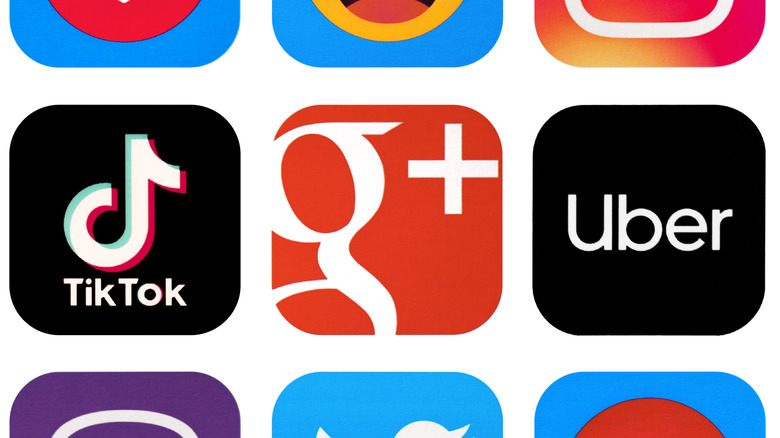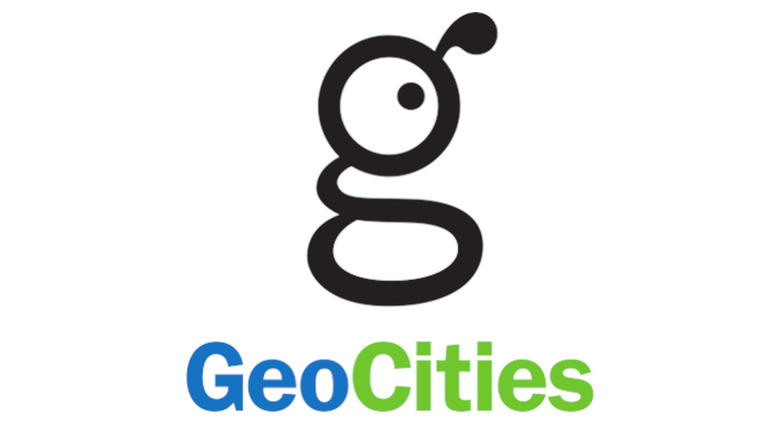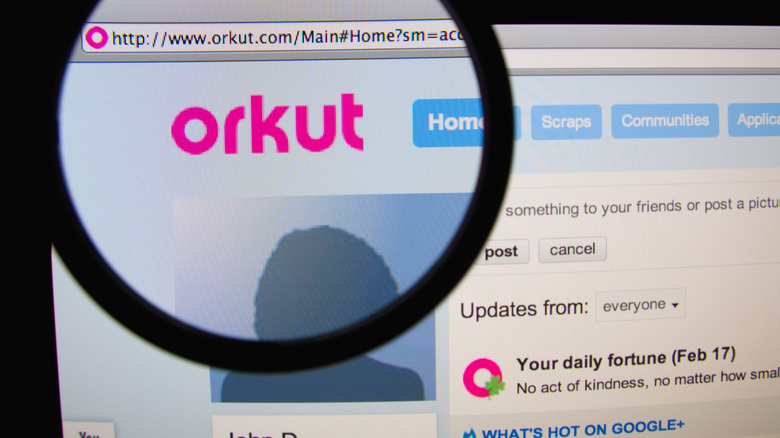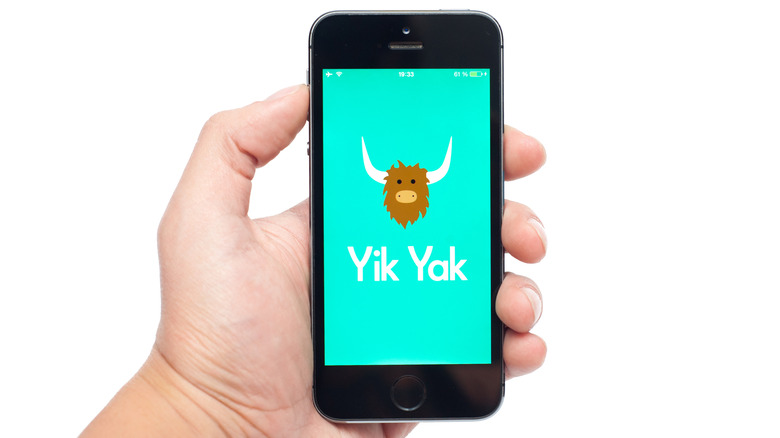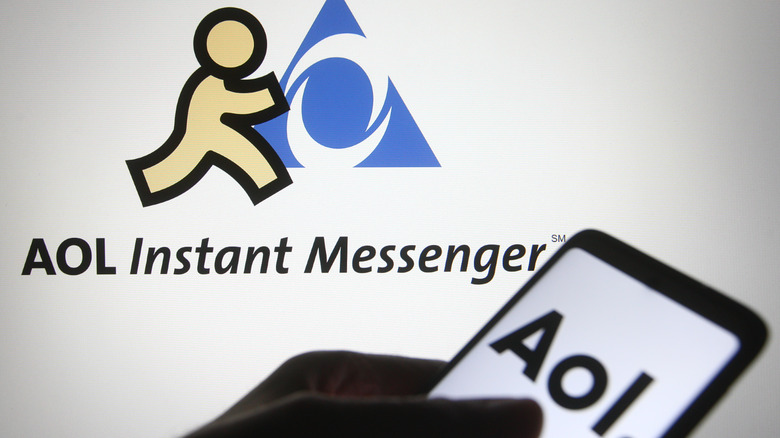The Surprising Evolution Of These Forgotten Social Media Sites
Sometimes it is hard to imagine a world without social media and to remember the world that existed before it. That's not to say that social media is so integral to life that one cannot live without it, but it is impossible to ignore its impact on public life. It can be even more impactful for those who use it daily, including those for whom it is part of their professional lives. Social media helps create wealth and offers a path to fame. It bypasses the gatekeepers of legacy media to give small businesses and artists exposure unheard of a couple of decades ago. It has also given us all a glimpse into how ordinary people think and that can often be frustrating and even alarming.
We arrived at this point from the efforts of many people and companies trying to realize the endless and unmapped possibilities of an internet-connected world. From nascent nineties startups to side projects of established tech firms, the Wayback machine holds the archives of plenty of failed ventures in connecting one another. Some of these ventures evolved into brands we know and love today while others still exist to fill roles different from their original intent. Some are cautionary tales on how much money can be wasted trying to compete. Mostly, with the rapid pace of development in the interconnected information age, these social media efforts get forgotten so here are some of the stories about how these social media sites evolved.
MySpace
For anyone who grew up without the internet and watched it grow into the necessary utility it is today, MySpace was probably their first exposure to social media. Its popularity coincided with the growth in broadband connections that introduced households to a world in which the internet was always on and always available.
MySpace started in 2003 and quickly grew to be among the most visited websites in the world. However, its reign as the leader was a short three years. Britannica lays out a timeline in which MySpace grew rapidly from 2005 to 2008, the year when rival Facebook caught up to it in registered user count. Before this event, MySpace was offered the opportunity to buy Facebook for $75 million – but declined. Later that year, Rupert Murdoch's Newscorp, the parent company of Fox News, bought MySpace for $580 million. But just a few years later, interest in MySpace began to wane as Facebook's interest grew exponentially, eventually leaving MySpace just a shell of its former self. By the time 2011 rolled around, MySpace's stature had fallen so fast that Newscorp unloaded it for just $35 million. MySpace exists today as a music promotion platform.
Vine
TikTok, YouTube Shorts, and Facebook Reels can all trace their existence to Vine, the short video platform that preceded them all. The unique feature about Vine that set it apart from its contemporaries YouTube and Instagram is the short duration limit of the videos — six seconds — and it pre-dated TikTok by several years.
Vine started in 2012 and was bought by Twitter shortly thereafter. Its creators had envisioned it as a place for sharing snippets of peoples' days and conveying tidbits of information to followers. Founders had not considered how it could be such a breeding ground for creativity. With a six-second time limit, creators were forced to work within the time constraints to build something interesting, and they did. Creators took off with the format and poured on the creativity. Vine had no filters, effects, or any other extras, and that lack of flare also forced creators to use their ingenuity to push the boundaries.
According to the Verge, Vine had trouble finding a place at Twitter and even more trouble figuring out how to turn a profit. The short video format appealed to many users, but others were a bit confounded by it, so Vine lost a bit of traction gained from its early success. Ultimately, Twitter canned the app and creators migrated to the other video sharing platforms. The New York Times spoke to Vine founder Dom Hoffman in 2020 and revealed that he has since created a successor app called Byte.
Friendster
Another of the early networks seeking opportunities to connect people was Friendster. Started in 2003 by software engineer Johnathon Abrams, Friendster aimed to connect people through their own personal networks. Unlike the dating sites that existed at the time or the various blogging platforms where random people could contact you or send an email, Friendster relied on connections of connections to put people in touch. At some point, you could not contact anyone more than six degrees separated in your own personal network (via Mental Floss).
The site saw immediate growth, with users shooting past a million in months and continuing that growth exponentially throughout its existence. But part of its problem was the growing pains associated with the meteoric rise in users...the servers could not handle it. Wired compiled an autopsy of sorts and clicked through the archives to determine what factors led to its demise. The technological factors played a part but user experience was also a factor. At some point, user connections failed to be as strong as needed to keep Friendster engaging. Also, competition from Facebook and MySpace added pressure to keep Friendster going and it just could not keep up. Friendster no longer exists except as a case study from Harvard Business School that can serve as a guide in what decision not to make for others in the future.
Google+
By 2011 the landscape of social media looked pretty well set. Facebook dominated personal interactions while YouTube handled videos, Instagram displayed our photo prowess, and Twitter continued to show us how arrogant our politicians really are. If anyone wanted to compete in a field such as this, they would need some seriously deep pockets and a desire to waste a lot of money. Enter Google and its take on social media, Google+.
Google had dabbled in the social media sphere previously but had yet to come up with a product that could dominate the space. June 2011 is when the company announced the product that would be the premier social media platform, Google+. TechCrunch explains that one of the big things Google did to differentiate its platform is to give users networks within their networks called Circles. This allowed users to share content for a particular group without sending it to all of their connections. The company hoped that the ability to separate personal and professional contacts gave Google+ an edge, along with other features, such as Hangouts, a group messaging platform.
Several missteps, such as not allowing nicknames or corporate profiles, led to user dissatisfaction with the service and huge problems with spam encroached on positive user experiences. In the end, despite pouring millions of dollars into the project, Google let it wither on the vine until it was primarily filled with spam content before officially pulling the plug in 2018.
LiveJournal
The story of LiveJournal is an interesting one with a sad ending. Like so many other popular entities on the internet, LiveJournal was started by a student in the late nineties. Its purpose is and was as a place for hosting blogs and served as an early form of social media.
LiveJournal enjoyed moderate success with rapid growth and, according to the Washington Post, peaked in 2005 with around 2.5 million users. The peculiar part of the decline in users for LiveJournal is that growth continued among Russian-speaking users and continued to grow long after its popularity waned in the English-speaking world. LiveJournal had become the de facto social media in Russia by 2010.
Russian firms later bought LiveJournal, sparking fears of censorship. But it was hosted on servers in California, outside the reach of Russian authorities, which alleviated fears of a Russian government crackdown. However, as the site became increasingly Russian-only, it also became fully under control of Russian companies and all of its operations were brought back to the motherland. The New York Times reported in 2014 that a law was passed that decreed any site with more than 3,000 visitors was now a publisher and subject to state media control. This change led to arrests and convictions and sharply curtailed the free speech that had long existed on LiveJournal.
LiveJournal now bears little resemblance to the original site and fully complies with the draconian media laws of the jurisdiction in which it resides.
Geocities
In 1994, the internet was a totally uncharted place where technologies were just figuring out their place and what to do with this new territory. Geocities provided people a place to talk about themselves. Started in 1994, Geocities set up a server to host personal web pages that could be built and designed however the user wanted and could cover any topic. It became a place to promote one's writing or music, as well as a place to promote a personal brand or product, serving as a precursor to today's social media. Different from the sleek and streamlined platforms we have today, Geocities offered a blank slate and anyone with minimal knowledge of HTML code could have a web page up and running in no time. This led to the bulk of content on Geocities being decisively amateur and not very good even by standards of the day, and downright comical by today's standards. Pages were grouped into neighborhoods that concentrated pages of similar interests together to help make finding topics easier but otherwise, users had little to guide their development (via HowToGeek).
The landscape presented by Geocities was vast, as Vice reported, it hosted up to 38 million web pages at its peak. Yahoo bought it in 1999 and closed it down in 2009, however, a repository of these now-defunct web pages was built and now hosts the remains of the once-powerful web tool at The Geocities Gallery.
Orkut
It can be easy as Americans to overlook how some products can gain popularity elsewhere when they fail to gain traction at home. Many companies have avoided failure by picking up audiences abroad, and social media platforms are no exception. Google got into social media much earlier than many realize with their social media concept, Orkut, so named after the Turkish engineer who developed it, Orkut Büyükkökten. According to Forbes, Orkut was launched in 2004 after a failed attempt to purchase Friendster and while Orkut gained a large following, the bulk of it was in Brazil and India.
Forbes also notes that the expansion of the user base in Brazil was wholly unintentional as Google did little to promote it there or in any other country. Somehow in Brazil and India, Orkut grew from organic growth and dominated in those markets until around 2011, when Facebook began to take the lead everywhere. Apple Magazine states that the rapid pace of development for all websites meant that Orkut failed to keep up as Facebook and others surpassed in technical prowess and offerings, and as such, poached more and more users. However, rumors have started bubbling up that a revival may be on the horizon, including a relaunch of the Orkut.com domain with a vaguely worded message from Orkut Büyükkökten himself.
YikYak
The idea of having social media with complete freedom of speech and no guardrails has been a popular sentiment as of late but it is not necessarily a new idea. Most people advocating for such things forget that moderation of content exists as a response to something. The lack of guardrails is primarily the reason Yik Yak is among the forgotten social media apps.
As the New York Times tells us, Yik Yak is an app created by two college students that differentiated itself by being restricted by geography. Users could post and share messages within a five-mile radius and identities were kept anonymous. The location-specific aspect of the app was a big draw for college students as so many peers would be gathered in a tight vicinity. The anonymity allowed users to converse about any topic with little concern of any repercussions or possible humiliation. However, this took a dark turn as the app quickie became flooded with harassment and bullying and even caused school campuses to be shut down with law enforcement being called due to bomb threats. These problems were further exasperated by a lack of response from the app's developers and their failure to moderate content and protect users.
Negative press and the threat of lawsuits ultimately caused the failure of Yik Yak and services for the app ended in August of 2017. Yik Yak has since been relaunched and is available for iOS only.
AOL
America Online, or AOL, was another creature of the nineties that may not be strictly referred to as a social media, but it featured many of the same elements. Initially, AOL was the portal to the internet for millions of people in the time of dial-up modems and slow internet on slow computers with meager capabilities. AOL was a sort of window into the world of information when websites were mostly text-based and images took time to load on screens.
AOL's heyday was in the nineties when millions of people experienced the internet through its interface. It included email, chat rooms, a web browser, and more. The UI displayed multiple tabs that could take you to shopping, travel guides, news, weather, and sports. It had games, a buddy list, and advertising. Your entire internet experience could be contained without ever leaving the AOL interface. AOL took advantage of this captive audience and added and updated its services continually until the user base began to decline when broadband entered American homes, giving users a direct line to the internet (via The Smithsonian).
AOL merged with Time Warner in 2000 in one of the largest corporate mergers to that date but began to see market share fall soon after, per Fast Company. It still exists as a subsidiary of Yahoo and still offers email and other services, such as identity theft protection. What was one of the defining features of a decade is now just a shell of its former self.
Second Life
Second Life would be a bit of an odd candidate for a list of social media platforms, but, strangely, it fits much better than one might think. If social media exists to allow people to connect and share their lives in its many forms, then Second Life might be the perfect social media — an immersive one.
Launched in 2003, Second Life is a virtual world where users choose avatars and build a digital life separate from their real life, but also as a part of it. Its growth during the 2000s was exponential and the platform generated a lot of attention, with feature stories in publications such as Business Week. While many might categorize it as a game, it is more than that. Second Life is an immersive experience in a digital world that can be whatever the user wants. The Atlantic tells of several people using it for things such as connecting to others who are also going through difficult events in real life, such as adoption or others in a special interest group who can commune together in real-time while being miles apart.
Mic tells us its user base had fallen to around a half-million users in 2018 despite having well over onr million in 2013, ten years after launch and early buzz. Second Life is still around, and some indicators are that it could be growing again.

